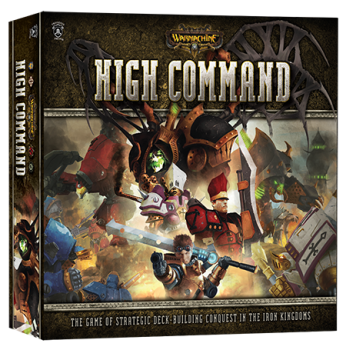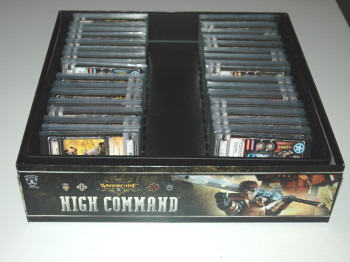Deck-Building Battles with Warmachine: High Command
 For me, a good game is really a window into another world. It’s like a miniature story that is told with a set of pre-defined rules. The war games I play are rarely just games, like tic-tac-toe or chess, but instead a single battle in a larger war, which in turn is part of the story of the rise and fall of nations and the struggles of the people within them.
For me, a good game is really a window into another world. It’s like a miniature story that is told with a set of pre-defined rules. The war games I play are rarely just games, like tic-tac-toe or chess, but instead a single battle in a larger war, which in turn is part of the story of the rise and fall of nations and the struggles of the people within them.
It was this perspective on gaming that first drew me to Privateer Press’s Warmachine line of miniature games. Though I loved the physical look of the figures, the fact is that I’m not an artist or a visually-compelled person as a rule, so it was really the setting that drew me in, the possibility to, in some small part, take part in the stories set in this world. And the giant warjacks didn’t hurt.
In fact, the first article I wrote for Black Gate was a review of Privateer Press’s Iron Kingdom roleplaying supplements, exploring their magically infused steampunk-style world of giant mechanical behemoths. Soon after, though, my involvement in Warmachine died off. I got married, became a father, and the disposable income to buy metal miniatures and disposable time to sit painting them went by the wayside (and there was a vast increase in anxiety, as little two-year-old fingers would inevitably seek to play with “Daddy’s dolls,” as they became known in my house).
Fast forward to the present, and it’s as if Privateer Press has found a solution to getting me back involved in one of my favorite gaming worlds. In addition to a whole new Iron Kingdoms line of RPG supplements (Amazon, Privateer Press) and digital fiction set in the Iron Kingdoms (Amazon), they have released a new deck-building game, Warmachine High Command (Amazon).
I described deck-building games a bit in a previous review of the Lord of the Rings: The Two Towers deck-building game, but if you aren’t familiar with the concept, here’s the basic way it works: Each player starts with a default deck of 10 cards that contain low-level statistics that are in turn used to purchase other, more powerful cards into the deck through the course of play. Some of the cards also have the benefit of eliminating cards from your deck, allowing for the strategic streamlining of the deck as the game continues. The game is won by the person who ends the game with the highest number of victory points, tracked by counting up the values of the cards you’ve got in your deck.

These cards are also in sleeves, which do not come with the game.
There are a few differences in High Command which are quite interesting and help add the flavor of the setting into the game.
First of all comes in the basic construction of the decks. In the other deck-building games that I’ve played (LOTR: The Two Towers, Marvel Legendary, and Ascension), there is one central deck of cards from which all players buy cards. High Command is different, in that each player picks a faction and builds an individual deck for that faction. The cards are based upon the figures from the miniature game, using the stunning graphics from the previous books and manuals, with powers that are thematically similar to their powers in the wargame, though it’s relatively rare for an individual card/unit in High Command to have more than one power.
The construction of these individual decks is also guided by the choice of warcaster. Each player is able to choose some warcaster cards to include, and there is color coding on the sets of cards that guide the way the deck is constructed. The warcaster is a one-use card that supports certain types of other cards in a single combat encounter.
Which gets us to combat. In addition to getting scored for the cards you buy into your deck, there are location cards in the center of the playing area, and cards from your hand can be played in order to attack those locations and possibly claim them. These are typically high-value cards toward the final point results, but they also go into your deck and can be used to generate resources to buy new cards.
There are two types of resources for purchasing cards: Command and War. Each card in a deck has a Command value and War value, and you discard cards from your hand in order to get those resources to buy cards. Some cards are more valuable in one type of resources than the other, and when you play them you have to choose which type of resource you’re using. So part of the strategy in building and streamlining the deck is anticipating which type of resources you’ll want to have available in your hand to get the other cards that you’ll need in order to attack a given location and defeat your enemy’s cards.
As if all of that wasn’t enough, one final unique twist on this game is the “Winds of War” deck. This is a series of cards that flip over each turn, giving some “plot twist” that offers a benefit or drawback to the game for that turn. The end of the game is when the “Day of Reckoning” card is pulled from this deck, triggering the final round. (The endgame can also be triggered when you run through the 15 cards in the Location card deck, but I haven’t had that happen yet.)
This is definitely not an introductory game for the novice, though it makes a good transition for someone who’s familiar with a diverse range of board and card games and is thinking of maybe moving on to playing a wargame, such as Warmachine itself. And of course, experienced wargamers will quickly adapt to the mechanics without much trouble. The rules are fairly complex for a game of this type, but far less involved than the full miniatures game itself.
High Command doesn’t take the place of the miniature game, but it creates a great alternative for those who like the basic play of the game but, for whatever reason, have gravitated away from it or find themselves unable to make the commitment in time and money required to play Warmachine itself.
Another great benefit to consider: A group of players with a single edition of the game can play on equal footing, without some players having the latest powerhouse warjack that can easily exploit weaknesses in another army because you haven’t been able to afford that new unit yet. (This happened to me on more than one occasion, expecially around the time Warmachine: Apotheosis came out. In some cases, I even owned the unit or warjack, but just hadn’t gotten around to assembling it yet.)
Privateer Press’s diverse range of products is way too extensive to contain within the single core boxed set, which is something of a blessing and a curse. In addition to expanding into the Hordes line, which focuses on titanic magical behemoth creatures in place of metal warjacks, there are a number of expansion packs slated for release in the coming months. Here are just a few of the current and upcoming products for use with High Command:
- Hordes High Command core boxed set (Amazon)
- Warmachine High Command: The Big Guns expansion (Privateer Press) – releasing Dec. 18
- Warmachine High Command: Into the Breach expansion (Privateer Press) – releasing in 2014
- Hordes High Command: Savage Guardians expansion (Privateer Press) – releasing in 2014
Disclaimer: Review copy of the game was provided by the publisher.
Andrew Zimmerman Jones is a writer of fiction and non-fiction. He has been a finalist in the Writers of the Future contest and received Honorable Mention in the 2011 Writer’s Digest Science Fiction/Fantasy Competition. In addition to being a contributing editor to Black Gate magazine, Andrew is the About.com Physics Expert and author of String Theory For Dummies. You can follow his exploits on Facebook, Twitter, and even Google+.
[…] Deck-Building Battles with Warmachine High Command […]